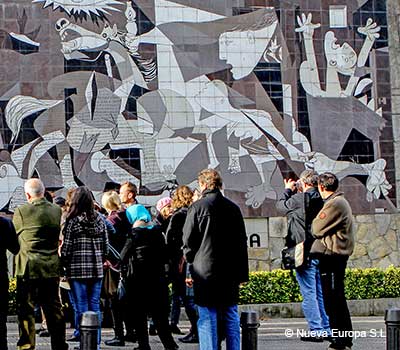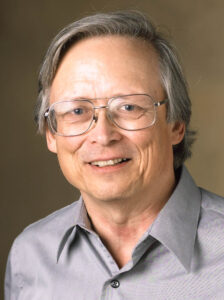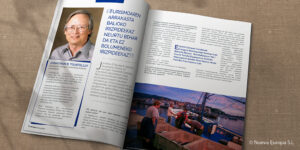
Urdaibai Magazine, la revista de información comarcal de Urdaibai que edita Nueva Europa, entrevistó en el año 2019 a Jonathan Tourtellot, autor de la definición de Geoturismo, en el que el turista se convierte en viajero. Una entrevista que recuperamos a través de este blog en su versión en castellano e inglés por estar de plena actualidad y que os animamos a leer.
ENTREVISTA COMPLETA CASTELLANO
«HAY QUE MEDIR EL ÉXITO DEL TURISMO
CON CRITERIOS DE VALOR, NO DE VOLUMEN»
JONATHAN B. TOURTELLOT Director del centro de gestión de destinos de National Geographic Society. Creador del concepto Geoturismo y autor de la Carta del Geoturismo, un conjunto de principios de gestión adoptados por destinos de todo el mundo. Periodista, editor, conferenciante y consultor. Dirige el Centro de Gestión de Destinos de National Geographic Society, cuyos objetivos son proteger los espacios emblemáticos del mundo, apoyar el turismo gestionado de forma inteligente y asesorar a los destinos. A lo largo de sus tres décadas de carrera, como editor senior en “National Geographic Books” y la revista “National Geographic Traveler”, ha escrito sobre geografía, medio ambiente, viajes y ciencia.
¿Cuales son los retos globales a los que tiene que enfrentarse el turismo en la actualidad?
La masificación, el cambio climático y una mentalidad, a la hora de tomar decisiones, que establece el valor del turismo solamente como una serie de transacciones industriales y dinerarias, teniendo poco o nada en cuenta la calidad y la personalidad de los destinos de los que el turismo depende.
¿Qué medidas básicas cree usted que deberían adoptarse para un territorio pequeño y todavía poco desarrollado como es el caso de Urdaibai, para integrar la actividad turística de una forma sostenible?
Medir el éxito del turismo con criterios de valor, no de volumen, pero un valor entendido no solamente en términos de beneficios económicos, sino también considerando cómo se reparten esos beneficios entre la comunidad y ayudan a preservar el patrimonio natural y cultural, que los visitantes han venido a conocer. Favorecer la clase de turismo que aporta otros beneficios a la sociedad, utilizando para ello, desde la educación y la colaboración de voluntarios, hasta una perspectiva filantrópica y el desarrollo de negocios apropiados. No evaluar el éxito solo por el número de llegadas de turistas. Eso es cantidad, no calidad.
A la hora de planificar nuestra estrategia de promoción y dinamización turística, ¿qué clase de actuaciones deberíamos evitar para que el turismo sea una actividad con un impacto positivo sobre la población y sobre el territorio?. ¿De qué nos podríamos arrepentir?
Bien, ¡vamos a ver lo que no hay que hacer! Hay que evitar el desarrollo genérico, cosas parecidas a los resorts, hoteles y atracciones del tipo de los que se pueden encontrar en cualquier sitio. Esta es una buena vía para atraer turistas genéricos, gente que busca solamente mejor tiempo que el que va a tener al volver a casa y que irá a cualquier lugar si otro destino le ofrece lo mismo más barato. Cualquier desarrollo turístico debería integrar aspectos diferenciadores de Urdaibai, o de Euskadi o de España (en orden descendente de importancia). Ese “mix” de autenticidad puede aportar a los turistas una rica experiencia que no puede ser duplicada en ningún otro lugar. Además, los beneficios procedentes de visitantes que están sinceramente interesados en Urdaibai, van a beneficiar a la población local y le van a incentivar para proteger el patrimonio natural y cultural, del que dependen sus ingresos.
Usted es el creador de un concepto tan atractivo como es el de»Geoturismo», el turismo geográfico, que hoy día se podría interpretar como el paradigma del turismo sostenible. ¿Cómo define el turismo geográfico? ¿Cual debería ser la actitud del turista, cuando visita otros territorios para que su impacto sea positivo y para ayudar a evitar que el turismo no termine siendo un problema global?
 La definición de Geoturismo, tal y como la presentamos en National Geographic es: “Turismo que preserva o mejora el carácter geográfico de un lugar su entorno, cultura, geología, estética, patrimonio, y el bienestar de sus residentes.” Nuestra investigación revela que la gente interesada en estas cosas—geoviajeros—están más tiempo y gastan más que la media de los turistas. Por otra parte: una definición alternativa con un significado más restringido de geotourismo, enfocado de forma explícita en la Geología, ha ido ganando terreno, en relación con el movimiento internacional de geoparques. Aunque claramente diferenciados, los dos usos del término son complementarios. En términos de calidad turística, cada uno añade interés al otro como se expone en la Declaración de Arouca hecha 2011 en el Congreso Internacional de Geoturismo. Si eres un viajero con una actitud geoturista, quieres mejorar un lugar en vez de degradarlo y la forma más fácil de hacerlo es colaborar con los negocios que conservan la calidad del lugar—negocios que no solo practican la sostenibilidad básica, sino que además difunden la naturaleza y la cultura del territorio. Gasta aquí tu dinero, no con otras franquicias internacionales, hoteles o restaurantes, iguales a los que vas a tener cuando vuelvas a casa. Cada euro que gastes es como un voto. Apoya la variedad, no la uniformidad. Tendrás un viaje más enriquecedor y te llevarás a casa más recuerdos. Y por supuesto, tienes que ser un visitante responsable y fomentar la misma conducta en los demás: Recicla tu basura, si es posible, respeta la cultura local, trata los lugares históricos con respeto, y deja a un lado el palo para selfies. Por supuesto, sacaos un par de fotos pero luego gira la cámara hacia el lugar y todo lo que este tiene que ofrecer. Esto es por lo que estas aquí, ¿no es verdad? Si viajas solo para probar que has estado en un destino más, no eres un geoviajero, solamente un selfie narcisista ocupando espacio y aumentando el problema del turismo masificado. Al contrario, aprende todo lo que puedas y cuéntaselo a la gente cuando vuelvas a casa y publícalo en Instagram y You Tube, que es mejor que publicar tu propia cara
La definición de Geoturismo, tal y como la presentamos en National Geographic es: “Turismo que preserva o mejora el carácter geográfico de un lugar su entorno, cultura, geología, estética, patrimonio, y el bienestar de sus residentes.” Nuestra investigación revela que la gente interesada en estas cosas—geoviajeros—están más tiempo y gastan más que la media de los turistas. Por otra parte: una definición alternativa con un significado más restringido de geotourismo, enfocado de forma explícita en la Geología, ha ido ganando terreno, en relación con el movimiento internacional de geoparques. Aunque claramente diferenciados, los dos usos del término son complementarios. En términos de calidad turística, cada uno añade interés al otro como se expone en la Declaración de Arouca hecha 2011 en el Congreso Internacional de Geoturismo. Si eres un viajero con una actitud geoturista, quieres mejorar un lugar en vez de degradarlo y la forma más fácil de hacerlo es colaborar con los negocios que conservan la calidad del lugar—negocios que no solo practican la sostenibilidad básica, sino que además difunden la naturaleza y la cultura del territorio. Gasta aquí tu dinero, no con otras franquicias internacionales, hoteles o restaurantes, iguales a los que vas a tener cuando vuelvas a casa. Cada euro que gastes es como un voto. Apoya la variedad, no la uniformidad. Tendrás un viaje más enriquecedor y te llevarás a casa más recuerdos. Y por supuesto, tienes que ser un visitante responsable y fomentar la misma conducta en los demás: Recicla tu basura, si es posible, respeta la cultura local, trata los lugares históricos con respeto, y deja a un lado el palo para selfies. Por supuesto, sacaos un par de fotos pero luego gira la cámara hacia el lugar y todo lo que este tiene que ofrecer. Esto es por lo que estas aquí, ¿no es verdad? Si viajas solo para probar que has estado en un destino más, no eres un geoviajero, solamente un selfie narcisista ocupando espacio y aumentando el problema del turismo masificado. Al contrario, aprende todo lo que puedas y cuéntaselo a la gente cuando vuelvas a casa y publícalo en Instagram y You Tube, que es mejor que publicar tu propia cara
¿Es el turismo interesado en la cultura, el patrimonio histórico, la personalidad del territorio, su entorno natural y las peculiaridades de las sociedades que visita, compatible con lo que se conoce como industria turística?
Si y no. Si, si se define “industria” como cualquier negocio cuya actividad principal se basa en el turismo, entonces es sin duda, parte de la industria. No, si esto es turismo en masa, grande en volumen y bajo en beneficios por turista. Es más, los destinos que acogen al turismo en masa tienden a ser incompatibles con los intereses que mueven a los geoturistas. Playas abarrotadas, parques de atracciones y una multitud de tiendas de camisetas no son lo que están buscando
Considerando que las certificaciones, sean de calidad, proceso, origen, etc…, adquieren, cada vez, mayor importancia en todas las áreas sociales, ¿considera necesaria la integración de los destinos en certificaciones de sostenibilidad y de compromiso con el medio ambiente?
Las certificaciones o las calificaciones (mi preferencia) ayudan, de alguna manera, a diferenciarte de aquellos destinos que no se preocupan en absoluto de la sosteniblilidad. Por un lado porque estimulan a los agentes menos implicados con su propio destino, y por otro porque monitorizan nuestros propios progresos.
National Geographic Society ha sido pionera en el mundo en la difusión de la riqueza natural, la cultura, el patrimonio y la ciencia y en la combinación de estas disciplinas con los viajes y la aventura, y ha llegado a crear un estilo, una forma de ver el mundo. Desde su perspectiva como responsable de un área tan representativa como la de destinos sostenibles, ¿Qué papel cree usted que debe de jugar la prensa especializada en el desarrollo de un turismo integrado y no invasivo?
Los medios de comunicación disponen de muchas vías para mejorar el comportamiento del turismo. Es mejor informar honestamente que promocionar. Si haces un buen trabajo, la historia que estas contando a tus lectores hará el trabajo de promoción. Los medios de comunicación necesitan potenciar de forma creciente destinos y lugares alternativos—algunos medios ya lo están haciendo— para evitar la masificación de algunos lugares famosos. Los medios, deberían fomentar el turismo responsable y hacer lo mismo con sus anunciantes. Aún más que en otras especialidades, los medios de comunicación de turismo, están especialmente cerca de sus clientes, una realidad impuesta por el coste económico de los viajes. Ahora, los medios, tendrían que ayudar a la formación de sus anunciantes en como promocionar sus destinos, sus viajes y sus estancias de forma más responsable. Es mejor desviar la atención de resorts genéricos y campos de golf y animar a los anunciantes a centrarse en las características únicas del destino, que son marketing.
Y ahora que sabes la diferencia entre ser turista o viajero… ¿Qué te consideras?
www.urdaibaimagazine.eus
———————————————————–
Do you know the difference between a tourist an a traveller?
INTERVIEW
JONATHAN B. TOURTELLOT Responses by Jonathan Tourtellot, CEO Destination Stewardship Center
- What are the global challenges facing tourism today?
Overtourism, climate change, and a decision-making mindset that assesses tourism value only in terms of industry transactions—money—with little if any regard to the quality and character of the destinations on which tourism depends.
- What basic measures do you think should be taken by a small and still underdeveloped in tourism territory, as is the case of Urdaibai’s Biosphere Reserve, to integrate tourism activity in a sustainable way?
Measure tourism success in terms of value, not volume: Value in terms not only of revenue, but how well tourism benefits are shared by the community and how well they help preserve the natural and cultural heritage that visitors are coming to experience. Invite the kinds of tourism that brings other benefits to the community as well, from education and volunteer help to philanthropy and appropriate business development. Do not measure success just by number of tourist arrivals. That’s quantity, not quality.
- In order for the tourism to be an activity with a positive impact on the population and the territory, what kind of actions should we avoid when planning our tourism promotion and promotion strategy? What could we regret?
Well, let’s look at what not to do! Avoid developing generic, look-alike tourism resorts, hotels, and attractions that could be seen anywhere. That’s a good way to attract generic tourists—people who seek only better weather than they have back home and who will happily go elsewhere if another destination offers the same thing cheaper.
Everything developed for tourism should reflect distinctive aspects of Urdaibai, or Euskadi, or Spain (in descending order of importance). That mix of authenticity can provide tourists with a rich experience that cannot be duplicated elsewhere. What’s more, revenues from visitors who are sincerely interested in the Urdaibai area will benefit local people and encourage them to protect of the natural and cultural heritage upon which their income depends.
- You are the creator of a concept as attractive as «Geotourism»: the geographical tourism, which could be interpreted today as a paradigm of sustainable tourism. Could you briefly explain how do you define geotourism?
And to the thread of this question, how should the tourist’s attitude be, when visiting other territories to make their impact positive and to help ensure that tourism does not become a global problem.
The definition of geotourism as we put forth via National Geographic is “Tourism that sustains or enhances the geographical character of a place—its environment, culture, geology, aesthetics, heritage, and the well-being of its residents.” Our research shows that people interested in those things—“geotravelers”—stay longer and spend more than the average tourist.
An aside: An alternate, much narrower definition of “geotourism” focusing explicitly on geology has gained traction in connection with the international geoparks movement. While clearly different, the two usages are compatible and complementary. In terms of tourism quality, each adds interest to the other, as set forth in the Arouca Declaration (downloadable in four languages) made in 2011 at the International Geotourism Congress in that Portuguese city.
If you’re a traveler with a geotouristic attitude, you want your presence to help enhance a place rather than degrade it. The simplest way to do this is to support the businesses that support the quality of the place—businesses that not only practice basic sustainability but also showcase the nature and culture of the place. Spend your money there, not with yet another international franchise hotel or eatery just like the ones back home. Each Euro you spend is like a vote. Support variety, not sameness. You’ll have a richer trip and take home more memories.
And of course, you need to be a responsible visitor and encourage the same behavior in others: Recycle your trash if possible, respect local culture, and treat historic sites with care. And do put away that selfie stick. Sure, take a couple of shots of yourselves, but then turn the camera instead toward the place and what it has to offer. That’s why you’re here, isn’t it? If you’re visiting just to prove you have been to one more destination, you’re no geotraveler, just a selfie narcissist taking up space and adding to the overtourism problem. Instead, learn everything you can and tell the people back home about it. Put it on Instagram and Youtube, rather than your own face.
- Is tourism interested in the culture, historical heritage, the character of the territory, its natural environment and the peculiarities of the societies it visits, compatible with what is understood as the tourism industry?
Yes and no. Yes, if “industry” is defined as any business that relies mainly on tourism, then it certainly is part of the industry. No, if it is mass tourism, high on volume and low on value per tourist footprint. What’s more, destinations catering to mass tourism tend to repel the tourists with the geotourism array of interests. Crammed beaches, amusement parks, and lots of T-shirt shops are not what they are looking for.
- Whereas that quality, process, origin, etc. certifications becomes of increasing importance in all areas of society, do you consider it necessary the integration of destinations into tourism certifications of sustainability and commitment to the environment?
Certifications or ratings (my preference) help, partly to differentiate yourselves from those destinations that care nothing about sustainability, partly to encourage any less-motivated stakeholders within your own destination, and partly to monitor as your own progress.
- The National Geographic Society has been a pioneer and a reference in the world in the dissemination of natural wealth, culture, heritage and science and of the combination of these disciplines with Travel and adventure, coming to create a style, a way of seeing the world. From your perspective as responsible of such a representative area as the sustainable destinations, What do you think is the role of the specialized press in the development of a respectful, integrated and non-invasive tourism?
Travel media have a variety of ways they can improve the conduct of tourism. It’s better to honestly inform than promote. If you do a good job, the story you tell and show your public will do the promotion job for you. Increasingly, media need to encourage alternative destinations and sites—some media have already started doing this—to avoid overcrowding the famous places. Media need to encourage responsible travel and do the same with their advertisers. Even more than other specialties, travel media are notoriously close to their advertisers, a reality forced by the expensive economics of travel. Now media may need to help educate their advertisers in how to promote destinations, tours, and accommodations more responsibly. Better to take focus off of generic resorts and golf courses and encourage advertisers instead to focus on the unique characteristics of the destination they are marketing.







